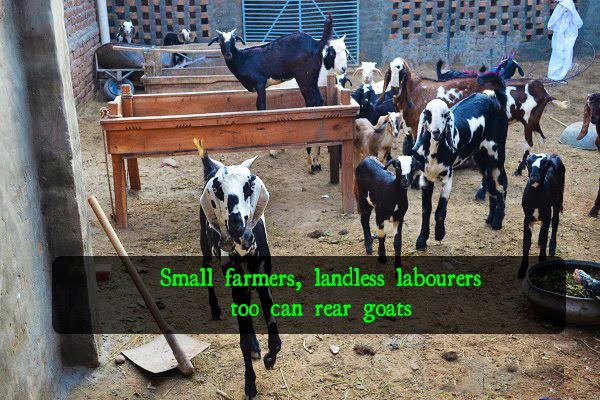From time immemorial Indian peasants have always been rearing animals for extra income.
But now all this is changing, with shrinking pasture lands and scarcity of green fodder, rearing farm animals is being considered un-remunerative.
To encourage small farmers and landless labourers to take up goat cultivation without having to spend much, scientists from Peruvannamuzhi Krishi Vigyan Kendra of the Indian Institute of Spices Research (IISR) have fine-tuned a technology.
CAREFUL PLANNING
“Our veterinary experts, through careful planning and breeding charts, have been able to fully exploit the reproductive efficiency of female goats. In a large herd, synchronization of estrus cycle by administering PGF2 alpha injection and timely breeding by using good quality frozen semen or natural service by superior male enhances not only conception rate for a female goat, but also the farmer can bring most of the females in a herd to deliver (kidding) at a specified period. In a herd of 50 animals, we can bring 10 or 20 goats to deliver in about 150 days at a time by this method. It is a boon to the farming community,” says Dr. M. Anandaraj, Director of the institute.
The institute has also formulated a technique for raising the goat kids. After 15-30 days the kids are housed inside a shed that is made of bamboo or wood with plenty of sunlight and ventilation for 120-140 days before being sold.
ONCE A MONTH
Once in a month the kids are also allowed to suckle from its mother 2-3 times a day before completely weaning them away.
Animals grown under this method attain 25-33 kg of body weight in 4-5 months compared to those animals grown under conventional method that attain only 10 kg in six months.
Initially the kids after being weaned away from their mother are fed small quantities of concentrated feed prepared specifically by the institute's experts.
Depending on the consumption, the feed quantity is slowly increased. Additionally liver tonics mixed with fish oil are also given to increase appetite and aid good healthy growth.
Clean water is made available all through the day.
The expense for feeding one kid comes to about Rs.1,200 a month and a net income of Rs.5,000 to Rs.7,000 can be got in some months by selling the kids.
This feed is also available in the market in some commercial brand names and farmers can also make them by mixing rice, wheat, maize, horsegram etc.
CONTACT
“Farmers can contact the institute at the address given below to clarify their doubts and learn more about this,” says Dr. S. Shanmughavel, animal science specialist of the Institute.
Various women self help groups and several individual farmers in Kozhikode district, Kerala, have started to rear goats in this method for the past few years.
Low cost, better return and easy management are some of the favourable factors that motivate farmers to take up this technique.
This has become a flagship programme of our Kendra because it helps rear more number of goats in a short span of time.
“The biggest advantage is that those who have only few cents of land can also grow goats. We need not spent much time grazing them out in the open. Managing a dozen goats is not a big task now for landless workers or small farmers,” says Dr. Shanmughavel
SUCCESS
The success of this technology is not confined to Kerala alone. Farmers from other states like Karnataka, Tamil Nadu, Andhra Pradesh, and Gujarat are visiting the Institute to learn more about this method.
For more details readers can contact Dr. S. Shanmughavel, Subject Matter Specialist (Animal Sciences), Krishi Vigyan Kendra, Peruvannamuzhi Post, Kozhikode: 673 528, Kerala, email: kvk@spices.res.in, Phone:0496-2662372. and also log on to YouTube Channel (http://www.youtube.com/iisrcalicut) to watch a documentary film on broiler goat rearing practice.

No comments:
Post a Comment